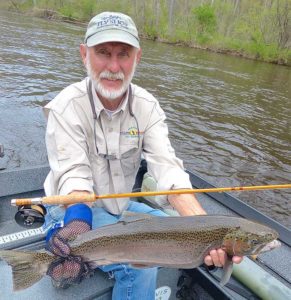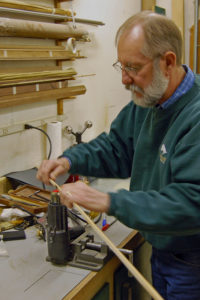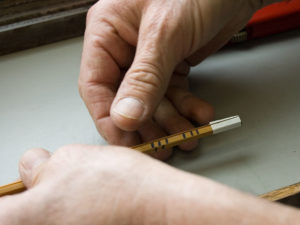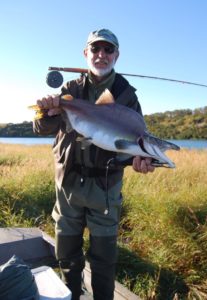
Too Slow, Too Soft, Too Fragile. Don’t You Believe It!
 As I travel around the country the stories I hear are as varied as the anglers that tell them. The stories, the tall tales, the campfire fodder are all about big fish and the methods and rods used to catch them. As a maker and collector of cane rods the stories that catch my attention are about bamboo. Bamboo, as in a split bamboo fly rod. The kind of rod your grandfather used to catch impressive brown trout from Michigan’s Ausable or Pere Marquette rivers, monster Rangeley Lake brook trout or silver sided screamers called rainbows in the American West. For almost a hundred years from Samuel Phillipe’s day in 19th century Pennsylvania up until the end of World War II, if a man went fishing, if he was serious about his sport, he carried and cast a split bamboo fly rod. So if these rods were good enough for granddad and his pals why aren’t they good enough for modern day anglers? Well, maybe they are.
As I travel around the country the stories I hear are as varied as the anglers that tell them. The stories, the tall tales, the campfire fodder are all about big fish and the methods and rods used to catch them. As a maker and collector of cane rods the stories that catch my attention are about bamboo. Bamboo, as in a split bamboo fly rod. The kind of rod your grandfather used to catch impressive brown trout from Michigan’s Ausable or Pere Marquette rivers, monster Rangeley Lake brook trout or silver sided screamers called rainbows in the American West. For almost a hundred years from Samuel Phillipe’s day in 19th century Pennsylvania up until the end of World War II, if a man went fishing, if he was serious about his sport, he carried and cast a split bamboo fly rod. So if these rods were good enough for granddad and his pals why aren’t they good enough for modern day anglers? Well, maybe they are.
The first time I witnessed a large fish hooked, played and landed on a split cane rod was more than 25 years ago. The location was Michigan’s Pere Marquette River in early April, the fish, a fresh run steelhead and the angler was noted Midwest rod maker, Leon Hanson. I, like almost everyone else on the river that day, was toting a new graphite rod, the latest in modern space age technology. As I waded around a bend and witnessed Mr. Hanson casting a cane rod to a pod of steelhead I thought to myself, “What the hell is this guy up to?” A few casts later I got my answer! Mr. Hanson, classic split bamboo fly rod in hand, was catching fish, big, leaping, chrome colored fish. Later that evening when I ran into Leon celebrating over dinner and drinks his steelhead score was more than mine. Hmmm? I had the new graphite rod and Leon stuck with a traditional cane rod. He caught more fish than me. Was I missing something?
That afternoon on the PM haunted me for years and years and in June of 2004 I decided to travel to the Big Fish capital of the Midwest, the rapids of the Saint Mary’s River to fish a cane rod for Atlantic salmon. The Saint Mary’s River defines the border between the United States and Canada in Michigan’s Eastern Upper Peninsula and is well known for monster trout and salmon. It’s a poor man’s Atlantic salmon River and John Giuliani is the areas best known guide. At dawn when a cane rod collector (better known as a caniac) from Ann Arbor, Michigan and I met our guide John G. I had expected to catch some flack for planning to fish a split bamboo rod in the treacherous Saint Mary’s rapids. On the contrary, Mr. Giuliani was of the opinion that guys who carried split bamboo fly rods, in his experience, usually did just fine. The edge, he thought, may be attributed to experience or the cane rod, he wasn’t sure and wouldn’t commit.
Anyway, both my pal and I used vintage 9’, 8wt. cane rods that morning and hooked fish, big fish! The rods were from another era and other rivers and as I sent cast after cast into the rapids I felt like I had stepped out of a Roderick Haig-Brown or Ernest Scweibert story. I wish this tale had a happy ending, for me at least, but that’s not the case. Although a 15 pound plus (Guide’s estimate) Atlantic salmon grabbed my tandem streamer, after the usual 1,000 casts, I was unable to land the fish. Did the rod fail? Did I do something wrong? Were the fish gods against me? Nope, after a long tug of war the hooks just pulled out! On a happier note my partner hooked and landed some very respectable 20 inch plus resident rainbows and a very powerful late run steelhead, a fish by the way that dwarfed the resident rainbows. Since that morning I’ve contemplated the loss of the big salmon and the 1,000 casts it took to hook up. I’ll remember the power of the fish but also the cadence of the cast and heft of a well balanced split bamboo rod. I’ll be back on the St, Mary’s again and I’ll bring a cane rod.
Big fish and fly rods can and do lead to disasters but when tragedy strikes, in most cases, a split bamboo fly rod can be repaired to fight another day. Take for example the story of a fellow I know, a well known angler and guide with a reputation bordering on celebrity, who went under-gunned one autumn day. The guy (who knew better) made the mistake of tangling with a full grown Chinook salmon armed with an 8ft. 6wt. classic Hardy C.C. deFrance. When the rod ended up in my shop for repairs, I knew right up front who had won the battle, the fish! Like so many of us mistakenly do, the angler, to slow the powerful surge of a runaway King salmon, had placed his left hand on the butt of the rod, halfway between grip and stripping guide. As the fish ran the rod blank exploded much like an obstructed shotgun barrel banana peels. I’ve witnessed similar situations with synthetic rods, only they snap clean and end up in the trash. Not so with a bamboo rod.
 With pins and razor blades, silk and glue, patience, lots of patience, I was able to repair the rod. Not as good as new, but it takes an experienced eye to find the mend. A classic brought back to life. The moral of the story, big fish break rods, split bamboo can be repaired to fight another day.
With pins and razor blades, silk and glue, patience, lots of patience, I was able to repair the rod. Not as good as new, but it takes an experienced eye to find the mend. A classic brought back to life. The moral of the story, big fish break rods, split bamboo can be repaired to fight another day.
This past summer I spent a week in Montana, home of big mountains, rivers and winds! For the pocket water of gin clear mountain streams I chose a 7’6” 3 pc 4wt cane rod, fresh from my shop. Its quick tip can shoot and pick up line before waterfalls and currents create a tangled mess. To protect the fine tippets needed to present small flys to fussy trout the rod was designed with a delicate tip, a design that filled the bill and my catch and release net.
Later in the week when we made it to the Madison, famous for big water and western wind, out came a vintage 1950’s Orvis Wes Jordan. Its 8ft length and ability to accurately cast a 7wt line allowed me to use sink tip lines and large streamers or when bugs started emerging turn over a 12 foot 5X leader. During my stay on the Madison I used both large wets and small dry flys, depending on the time of day, and the old Wes Jordan’s versatility enabled me to go armed with just a single rod.
My week in Montana was a mixed bag filled with a variety of trout taken in a variety of water. Whenever I’m out and about I’m always amused at the reactions I get when the fishermen I meet realize I’m carrying a bamboo fly rod. The rod is either held in awe or deemed a quaint throw back to an earlier era, never really taken serious. Their opinion changes once I start hooking and landing fish, especially big fish. In 5 days on the river I met dozens of anglers and only one other guy fished cane, but he sure smiled a lot.
So now that you’ve read my stories about adventures with a cane fly rod, what’s my point? Simply this, there are a lot of misconceptions about bamboo fly rods. Misconceptions like a split cane rod is really too fragile to be taken seriously or that bamboo is a material which produces slow, soft rods, incapable of meeting the needs of modern anglers. Well, after a lifetime of fly fishing, and 15 years of experience making and using cane rods, I believe there is another side to the story. And if you will allow me a few more paragraphs I’ll tell why.
 Bamboo rods are too slow. Early split or rent cane rods were made of Calcutta cane. This material was indeed slow and not as well suited to rod construction as the later choice of Tonkin cane. Fortunately one has to search pretty hard to find a Calcutta rod today as the Tonkin (Arundinaria amabilis) bamboo is the standard material used in making a bamboo fly rod. Tonkin cane, through selection and tempering, can be fashioned into rod sections which are as fast and varied as other rod construction materials. Add to this the use of modern adhesives which lend stiffness and speed to the blank and a lot of things change. But in my book, stiff rods and lightning fast casts, just snap off flys! A competent rod maker can design and create a fast tip rod or any other taper the angler prefers, that’s the beauty of cane, the material can be hand planed or machined to amazing tolerances and specifications.
Bamboo rods are too slow. Early split or rent cane rods were made of Calcutta cane. This material was indeed slow and not as well suited to rod construction as the later choice of Tonkin cane. Fortunately one has to search pretty hard to find a Calcutta rod today as the Tonkin (Arundinaria amabilis) bamboo is the standard material used in making a bamboo fly rod. Tonkin cane, through selection and tempering, can be fashioned into rod sections which are as fast and varied as other rod construction materials. Add to this the use of modern adhesives which lend stiffness and speed to the blank and a lot of things change. But in my book, stiff rods and lightning fast casts, just snap off flys! A competent rod maker can design and create a fast tip rod or any other taper the angler prefers, that’s the beauty of cane, the material can be hand planed or machined to amazing tolerances and specifications.
Bamboo rods are too soft. The term soft is kind of misleading as degrees of soft or hardness is subjective rather than objective. Bamboo rod blanks are admittedly not as stiff as graphite but when properly designed certainly more so than fiberglass. But why modern tackle makers have chosen to manufacture synthetic rods as stiff as pokers is beyond me. Stiff rods wear me out! They aren’t much fun to cast. By the end of the day my arm hurts and their unforgiving tips break off good fish. Quote me on that one. Just a week ago I hooked and landed a fresh run Michigan steelhead on a 50 year old Leonard Duracane rod. The rod measured 8’6” and matched well with a WF #7 line. Its soft tip and progressive action did an admirable job of protecting my 3X tippet while bringing the fish to hand. Rod action whether soft or stiff, is often controlled by the marketplace and not good angling sense. As for me, I’ll stick with the traditional feel of a well designed split bamboo fly rod.
 Bamboo rods are too fragile. Here’s a true story. The night was humid and dark but the big flys were hatching. Our angler cast to the sound of a bowling ball being tossed into the river and the fish took. Long minutes later 28 inches of brown trout lay in the net. The angler’s rod was a 7 foot, split bamboo, Dickerson 4wt. taper. Too fragile, I don’t think so.
Bamboo rods are too fragile. Here’s a true story. The night was humid and dark but the big flys were hatching. Our angler cast to the sound of a bowling ball being tossed into the river and the fish took. Long minutes later 28 inches of brown trout lay in the net. The angler’s rod was a 7 foot, split bamboo, Dickerson 4wt. taper. Too fragile, I don’t think so.
Fly rods break out of carelessness. With the exception of steel, it doesn’t matter what they are made of. Screen doors and car doors have ruined more rods than big fish. I have broken a few rods in my day, both synthetic and bamboo, and in every situation my own stupidity was to blame. The difference between synthetic rods and bamboo is that cane rods can most often, not always, be repaired or new sections replaced. Besides that they sure are nice to look at, fragile or not.
Bamboo rods are too expensive. I’d like to wrap this up by taking a minute to discuss costs. Are bamboo rods too expensive? Well maybe, depending on one’s budget. But a single tipped, field grade, bamboo rod, made by a reputable craftsman will often be about the same price as the high end graphite rods on sale today. Keep in mind cane rods like fine furniture and wooden stringed instruments often appreciate in value while cars and plastic rods depreciate
If you have the opportunity to fish lakes and big rivers then there are lots of good serviceable 3 pc 8’6” rods on the used (make that pre-owned) market. Rods with a little tender loving care can be restored and provide the angler with years of use. If you don’t believe me take a look at John Gierach’s book, Fishing Bamboo.
While on the subject of books there are at least a half dozen “How-To” books which enable the average woodworker to create his or her own bamboo rod. Authors like Maurer and Elser, Howell, Gould, Barnes, Garrison and others are author/craftsmen who have written about the secrets of making a split bamboo rod. If you can tie your own flys you probably can make a cane rod. And if you need a little encouragement rod making schools and classes are also available, just check the internet.
Let’s say you live in the Midwest and want to shell out some cold hard cash and get into fishing a cane rod, who can you trust? In Minnesota Dave Norling is a good bet and in Wisconsin you won’t go wrong with Don Schroeder. Moving South and East a call to Bill and Eric at Coren’s Rod Shop in Chicago would be worth your time. If Michigan is your home try Wes Cooper, Leon Hanson or John Pickard. Oh ya, don’t forget Ron Barch. He can make a decent rod if he isn’t out fishing! And in Ohio Jeff Wagner is well known for his craftsmanship. There are other competent rod makers in the Midwest but I’m familiar with the workmanship of these craftsmen and am comfortable sticking my neck out to recommend them.
So are split bamboo fly rods too slow, soft and fragile? You be the judge. I hope I’ve changed some minds and destroyed some myths.
In conclusion let me share what renowned Michigan rod maker, Paul Young, had to say along time ago. “Landing 4 lb. trout on a 1 ¾ ounce rod and size 20 dry fly understandably sounds like a paradox. Actually, when using these small hooks and their requisite 5 or 6x tippets your chances of landing fish of this size are better on an extra light rod such as the Midge than a heavier one. It will absorb more of the shock and consequently put less tension on the tippet and the small area of hook contact.” This was true back then due to the qualities of split bamboo and it remains true today.
See ya on the river.




Milosj de Groot
Hi might you be interested in picking up some realy Nice rods? I have some you might be interested in. I am the son of Hans p c de Groot and have some for sale. I have a few Tom morans in mint condition. Verry rare rods even have some signed. He was an old friend of my dad.